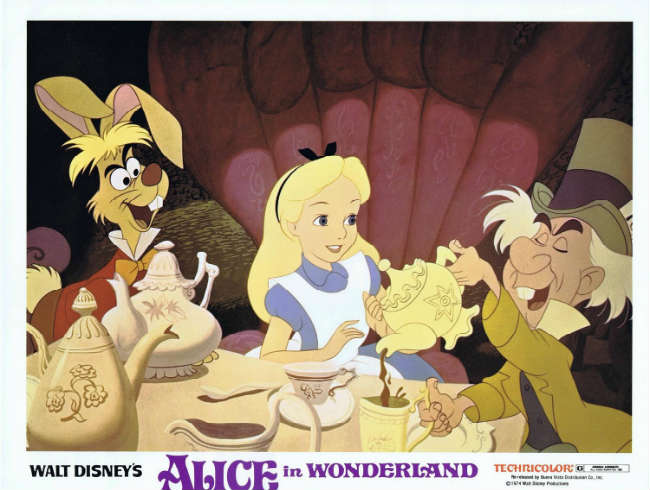
Welcome to Revisiting Disney! Today, we’re looking at a film that is, in many ways, a cult classic (as much as a Disney film can be a cult classic), Alice in Wonderland! I’ve labeled each category, so if you want to skip to the parts that interest you most, feel free. And, of course, if you have any thoughts, burning or otherwise, please share in the comments!
BACKGROUND
Alice in Wonderland was released in theaters on July 26th, 1951. Like many of the Disney films of the late ’40s and early ’50s, Alice was in development for quite a long time before it was completed. It took five years to create, but the studio had been planning Alice for at least ten years.
Sadly for the studio, Alice was not a success at the box office. Luckily, Cinderella had recently come out and the studio was not in danger of closing as a result though the failure of Alice did wipe out the Cinderella profits (Thomas 1992: 102).
During the ’60s, the film became much more popular and did become a bit of a cult classic. Ollie Johnston, one of the Nine Old Men and a Supervising Animator on Alice said that the animators were often asked later what they were on while making Alice (Thomas 1992:102).
Alice in Wonderland is also interesting because it was the first of the animated films to be shown on television, appearing on the program Walt Disney’s Wonderful World of Color in 1954. The studio was also able to use television to do additional advertising for the film, airing a black-and-white “One Hour in Wonderland” behind the scenes program in 1950 (it’s included on most DVD copies of Alice and worth the watch).
On the “Reflections of Alice” segment on my DVD, every animation historian talked about how Alice in Wonderland seemed to be tailor-made for the Disney Studio to adapt, and recalled how much Walt himself seemed to love the story, having been trying to adapt it for ten years and having used the story in other shows.
This was especially interesting to me when reading Bob Thomas’s account of talking with Walt about Alice in 1963. Walt told him that “I think Alice got what she deserved. I never wanted to make it in the first place, but everyone said I should.” (Thomas 1992: 101).
As Alice in Wonderland by Lewis Carroll was, and still is, a very popular novel, Alice presented a particular set of issues. Although the book and its sequel (Through the Looking Glass) have a lot of material (so much that the animators and historians on the Behind the Scenes feature say that every adaptation is fresh and can draw on different parts of the story), book purists can be very picky, particularly when it comes to beloved classics. The film was trying to cater to both fans of the book and Disney fans; at the time it was hard-pressed to do either.
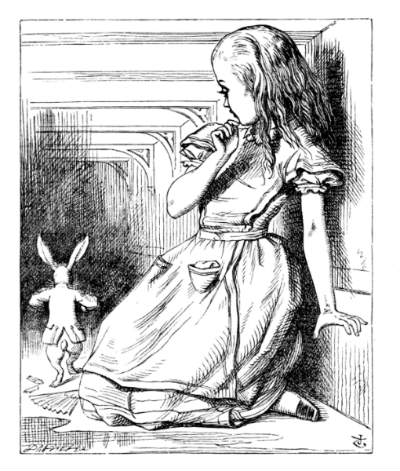
The Studio had been working on the story since 1933, had the rights to the original illustrations by John Tenniel and even had novelist Aldous Huxley working on story ideas in the late ’40s, but the story proved problematic. The pictures were too detailed to adapt and lacked whimsy, Huxley’s adaptation was too close to the book and too intellectual to translate well to animation, and, basically, no one was having fun.
MUSIC
The music in Alice was composed by Oliver Wallace, who had worked on Dumbo and Cinderella and would also work on Peter Pan. Due to the challenges with the story, the music, and the art were what the film relied on to carry it. Some people claim that over 30 songs were composed for the film.
There was an alternative song for Alice in the opening, a song each for the Cheshire Cat and the Caterpillar, and numerous other pieces that were either remade into other songs for other films or used in the background as part of the score.
Additionally, Alice was nominated for an Oscar in 1952 for Best Music, Scoring of a Musical Picture.
ANIMATION
Although I’ve mentioned her before, this is the time to really talk about Mary Blair. She was born in October 1911 in California and would pass away in July 1978. Blair worked for the Disney Studio, particularly in color and styling. She was trained in watercolors and her art is a bit more abstract than the company used in the earlier films, particularly Bambi and Pinocchio.
Blair used color, fun and different graphics and, although it looks simple, her art is beautifully sophisticated and masterfully crafted. For more information, check out this website full of details about Mary Blair. The site was put together by her nieces and has information from John Canemaker, who literally wrote the book on her (The Art and Flair of Mary Blair).
The beautiful backgrounds seen in Melody Time, The Adventures of Ichabod and Mr. Toad, Cinderella, Peter Pan, Alice and Wonderland and the shorts “Donald Duck Visits Lake Titicaca” and “Once Upon a Wintertime” all were under her direction and in her style. Mary Blair would be honored as a Disney Legend in 1991.
The animators seem to have really hated Alice (I know, kick in the childhood, right?), and Marc Davis and Ollie Johnston both spoke to Bob Thomas about their feelings at the time.
Marc Davis said that “Alice herself gave us nothing to work with. You take a nice little girl and put her in a loony bin, and you have nothing…she had nothing to work with other than facing one nut after another,” while Ollie Johnston remembered that “Walt blamed it on us, we blamed it on him. He said, ‘You guys didn’t get any heart into it; it was too mechanical.’ He was right though it wasn’t necessarily our fault. It was everybody’s, I guess.” (Thomas 1992:101-2).
The memories of these two men line up pretty well with how most critics tend to see the film; technically brilliant but lacking a certain something. A major problem, according to Christopher Finch, is that the original novel is full of “Carroll’s highly intellectual verbal humor” and that it was difficult to translate to the animated medium. (Finch 1975: 117).
Finch calls Alice “the weakest of Disney’s animated features” and recalls that Walt and his animators felt that the character of Alice herself “lacked heart.” (Finch 1975: 117). This fits beautifully into what animators Davis and Johnston said above, and could have resulted from trying to take a book that is full of math jokes and other intellectual bits of humor and trying to make them come across visually and for children.

Adrian Bailey adds to the discussion by saying that the original story is not one easily adapted; he says that Carroll already had placed his brand of fantasy on the story. It’s a very surreal and eccentric tale, and Tenniel, the original artist, had already created art to balance out the story.
He points out that Alice in Wonderland is not a “cute” story, and it had violent characters and peril that did not lend the film to become cute or “Disney-fied” in the way other films had. There were also five directors, each trying to outdo the other in their sequences; creating a too many cooks feel.
THE PLOT
Alice in Wonderland is the story of a little girl, Alice, who, one day, sees a rabbit in a coat with a pocket watch. Being bored and very curious, she follows him to see where he is going and ends up in Wonderland.

Here, she meets many strange and wonderful characters. These include a talking door, a Dodo directing other animals running a caucus race, Tweedle-Dee and Tweedle-Dum, the Cheshire Cat, the Mad Hatter, March Hare and Dormouse, Bill (the lizard with a ladder), and the Queen of Hearts and her court.
Most of these adventures are broken up into little segments. When Alice arrives in Wonderland, she shrinks down to fit through the door but is trapped (it’s locked, you see). She grows to grab the key and ends up very large indeed. Alice starts to cry, creates a flood, floats about in a bottle for a bit, joins the caucus race and follows the White Rabbit into the forest.
There, she meets Tweedle-Dee and Tweedle-Dum, who tell her the story of “The Walrus and the Carpenter.” She finds the Rabbit and his house, is mistaken for a maid, grows again, is mistaken for a monster, shrinks again and chases the Rabbit. Being only three inches tall, she talks to the flowers, who, although they are very pleasant, later get the idea that she’s a weed and shoo her out of the garden.
Still short, she meets the caterpillar and is able to grow tall again, after confessing that she is really confused (as are we all). Logic doesn’t seem to apply in this world and that baffles her. This is not helped by her conversation with the Cheshire Cat or her attendance at the Mad Hatter and March Hare’s tea party.
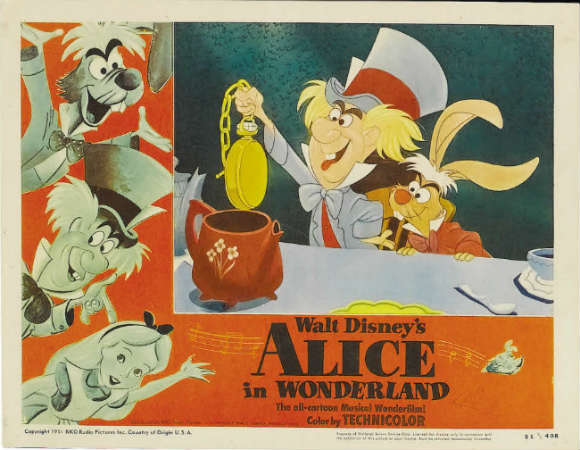
After a surprisingly traumatic scene where Alice is lost, scared and alone in the forest, the Cat appears again and guides her to the castle of the Queen of Hearts. Here, Alice paints the roses red, plays croquet and has a trial.
When she underestimates both the Queen’s temper and her own, Alice finds herself running through Wonderland trying to get home. Turns out, she was asleep the whole time, and when she wakes up, she is very grateful, despite having not listened to her history lesson. Luckily, it’s tea time (Alice is a very British little girl who has been trying to get a good cup of tea since the tea party).
SOURCE MATERIAL
Alice in Wonderland, with its sequel, Through the Looking Glass and What Alice Found There are both very full of material and are constantly being adapted into new books, movies and television shows. The novels were written by Lewis Carroll, which was the pen name of a mathematician and professor at Oxford, Charles Dodgson.ich was the pen name of a mathematician and professor at Oxford, Charles Dodgson. Dodgson wrote the stories for the Liddell sisters, particularly Alice. The Liddell girls were the daughters of one of the deans at Christ Church College, where Carroll worked.
Alice in Wonderland was originally published as Alice’s Adventures in Wonderland in 1865, with the sequel published in 1871.
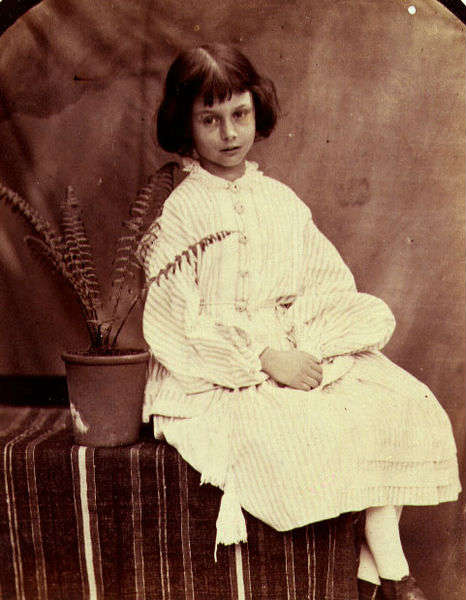
The novel is full of jokes, ranging from math jokes to literature jokes. Overall, it’s a very clever novel that still holds up as hilarious today. When I read Alice in Wonderland as a kid, I thought it was very funny. Even if I didn’t get all the jokes, it was still whimsical and fun.
Reading it as an adult, I still find it hilarious. Though I don’t actually get the math jokes, I have been told that they are there and quite fun. The logic puzzles and other jokes embedded in the story also make it fun on every reread. Disney pulled bits from both books in this story, and that’s part of what makes their take unique.
One of the earliest attempts by Disney to adapt Alice was done in the 1930s and was much closer to the book. However, it was actually rejected because Disney thought it was too scary. Despite that, the story has been adapted by Disney again with the scarier aspects included, most notably in the 2010 film version with Johnny Depp as the Mad Hatter.
RELATED: TV Mini-Series Review: Alice
Other recent adaptations include a spin-off of “Once Upon a Time” called “Once Upon a Time in Wonderland” and Syfy’s Alice (my personal favorite), plus many books and graphic novels.
It’s a story that can facilitate many, many adaptations, as long as the group doing the adapting is willing to commit and make the story theirs. I think that’s where Disney had trouble, they were trying to appeal to too broad of a crowd and didn’t really make the story their own (or at least, it seems that they felt that way).
The 1950’s
Like last week, this film encompasses several decades. As it was released in 1951, I’m placing it in the ’50s.
RELATED: Revisiting Disney: Cinderella
Alice herself is a product of her time. She is respectful of her elders, at least initially. By the time she stops showing them respect, she has realized that she is in a world where the usual rules do not apply. Since the family unit was a very important part of the ’50s, and respect for elders was emphasized, this makes sense.
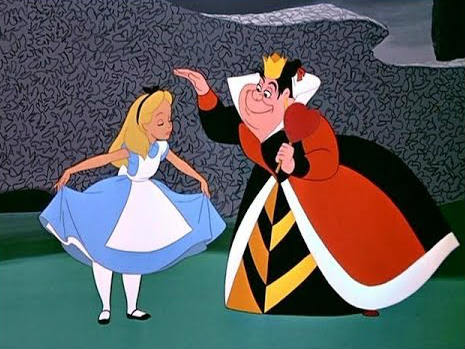
This is basically what I said about the ’50s last week, but I think it bears repeating. The ’50s are the era that people most think of when discussing “the good old days,” and it’s not hard to see why. At a glance, things were going well. Unemployment and inflation were both down, the industry was booming and new technologies were being developed. Suburbs were developing, the population was booming, and the clothes were pretty awesome too.
However, there was a dark side to this prosperity. Yes, the 1950s was a time of prosperity and economic booming, a time of relative peace and prosperity. But the 1950s were also the era of the Cold War and the rumblings of the Civil Rights Movement and the Feminist Movement could be heard. Both of these movements would start in the ’50s and gather speed in the ’60s (when they would come to a head).
LESSONS LEARNED
I don’t know what lesson Disney wanted me to learn from this film, but I would say that the biggest thing I took from this film was the danger of curiosity and the importance of minding your own business. Alice followed the White Rabbit down a mysterious hole, got hopelessly lost and almost had her head chopped off. This all happened because she wanted to know where he was going, a fact that was, honestly, none of her business.
Two more lessons come from “The Walrus and the Carpenter, or, The Curious Oysters.” First, listen to your mother and don’t let yourself be sweet talked into doing otherwise. Mother Oyster warned her children to not go with the Walrus, but they didn’t listen. His song and charming nature persuaded them to go with him anyway, and they were all eaten.
Secondly, watch out for who you trust. This doesn’t just apply to the oysters, but also to the Carpenter. He was under the impression that he and the Walrus were partners, sharing the work and the reward. However, the Walrus not only somehow made it so the Carpenter did all the work, but he (the Walrus) got all the reward. The poor Carpenter didn’t even get any oysters.
Another moral is don’t eat everything you find, even if it’s labeled. You never know what it will do to you. It might make you grow, shrink or change color. This is more of a joke moral, but I never understood (and still don’t) how Alice was still getting into trouble and changing sizes by eating things just because they were labeled “Take One” or “Drink Me.” Why would you eat a mysterious substance?! Of course, I might feel this way because of this story, so there is that.
My favorite moral, however, is that we’re all mad here, as the Cheshire Cat said. My parents have a quote on their fridge that says, “We all have a screw loose somewhere. Find it, accept it and deal with it,” (or something to that effect). I love this and think that’s part of the reason the film still has so many fans.
Not only is the story timeless (with so much potential for being adapted!), but it acknowledges that everyone has quirks and because of that, we really just need to acknowledge them and take pride in what makes us unique.
DOES IT HOLD UP?
Even though the animators didn’t like it and lots of people at the time of release also hated it, I still think it’s a fun movie. Alice in Wonderland has fun characters, catchy music and beautiful backgrounds. Lots of people love this movie because of these things, and the eccentric and bizarre turns it takes.
Really, I can see why the Disney Studio found it to be difficult to adapt, but it does manage to convey the spirit of the original novel and, let’s be honest, it’s imprinted on our collective brains. You can learn a lot of things from the flowers, you know. Have a Very Merry Un-Birthday!
For next week: Peter Pan
If you enjoyed this post and the others in the Revisiting Disney series, and have found yourself wishing that you could find them all in one convenient and bound book with eight extra essays, there is an option for you! Check out A Journey Through Disney: My Look Back Through Disney Canon, now available on Amazon as both a Kindle book ($4.99) and a paperback ($11.99).
OTHER SOURCES:
https://thewaltdisneycompany.com/about-disney/disney-history
http://www.history.com/topics/1950s
http://magicofmaryblair.com/
http://studioservices.go.com/disneystudios/history.html
Bailey, Adrian. Walt Disney’s World of Fantasy. Everest House Publishers. New York, New York. 1982.
Finch, Christopher. The Art of Walt Disney: From Mickey Mouse to the Magic Kingdom. Harry N. Abrams, Inc. New York, New York. 1975.
Kitch, Carolyn. The Girl on the Magazine Cover: The Origins of Visual Stereotypes in American Mass Media. University of North Caroline Press. Chapel Hill and London. 2001.
Sale, Roger. Fairy Tales and After: From Snow White to E.B. White. Harvard University Press. Cambridge, MA, 1978.
Tatar, Maria. The Annotated Classic Fairy Tales. W.W. Norton and Company. New York and London, 2002.
Thomas, Bob. Disney’s Art of Animation From Mickey Mouse to Hercules. Hyperion. New York, New York. 1992.
Wright, Gordon. The Ordeal of Total War: 1939-1945. Harper Torchbooks, Harper & Row. New York, Hagerstown, San Francisco, and London, 1968.
ARE YOU A ROMANCE FAN? FOLLOW THE SILVER PETTICOAT REVIEW:
 Our romance-themed entertainment site is on a mission to help you find the best period dramas, romance movies, TV shows, and books. Other topics include Jane Austen, Classic Hollywood, TV Couples, Fairy Tales, Romantic Living, Romanticism, and more. We’re damsels not in distress fighting for the all-new optimistic Romantic Revolution. Join us and subscribe. For more information, see our About, Old-Fashioned Romance 101, Modern Romanticism 101, and Romantic Living 101.
Our romance-themed entertainment site is on a mission to help you find the best period dramas, romance movies, TV shows, and books. Other topics include Jane Austen, Classic Hollywood, TV Couples, Fairy Tales, Romantic Living, Romanticism, and more. We’re damsels not in distress fighting for the all-new optimistic Romantic Revolution. Join us and subscribe. For more information, see our About, Old-Fashioned Romance 101, Modern Romanticism 101, and Romantic Living 101.

A fascinating read! I didn’t realize that Alice had done so poorly in the box office. Or that the animators and Disney himself felt conflicted about the movie as well. Pretty much all these old Disney films are classics to me that I loved watching as a kid so it has a soft place in my heart, even though I have to agree that its beautifully animated but isn’t as easy to connect with emotionally.
I’m glad you enjoyed it, Faith! Yeah, I hadn’t realized that until I started doing some research and found interviews. But despite that, it’s still a gorgeous movie, even if it has less of an emotional punch.